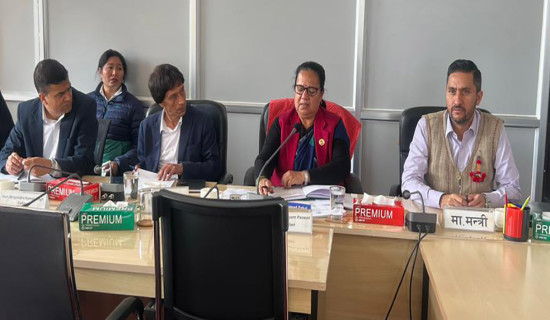- Wednesday, 3 December 2025
Political Culture For Constitutional Governance
Associate Professor of Law Dr. Suresh Kumar Dhungana, in his concluding remarks on the book, which is under review, opines that ensuring a fair political culture is of the utmost importance to successfully implementing the Constitution of Nepal. It is important because the political parties are the major agents and stakeholders in the newly promulgated constitution. It demands a constructive role from the political parties for effective implementation of the constitution. The author's
observation also indicates that the political actors should develop a fair political culture, which is lacking in the present politics of Nepal.
Of course, the political parties should be responsible, accountable, and sincere in their efforts to implement the constitution, and this is the crux of the book that the author wants to highlight. The nation is suffering from a chain of instability and has changed the constitution over a half-dozen times. Movements are launched against the political system, but the causes of the failure of the system and its actors governed under the particular constitution or political system are not properly diagnosed. So, there is no doubt about developing a constitutional culture where all political actors shall abide by the laws introduced in line with the spirit of the Federal Democratic Republican Constitution of 2015.
As a politico-legal document, the constitution alone cannot function well in the absence of sincere and honest efforts from the implementers or actors. In this sense, the observation of the author of the book is valid as well as logical.
The research-based book, penned by constitutional law expert Dr. Dhungana, has multiple targets. On the one hand, it shall be a good resource material for those who are pursuing formal degrees under the law faculty, and on the other hand, it serves as a reference material for the law practitioners. The smooth flow of language and well-crafted knowledge incorporated in the book justifies the title as well as the content of the book. The book has amply presented the history of constitutional development in Nepal since 1948 and a witty analysis of the Federal Democratic and Republic Constitution of Nepal, which was promulgated in 2015. This perspective of the book has added extra value to the book as there are rare materials available in the market that are authentic. The author has cautiously tried to make the book more authentic by following the uniform rule of citation and applying the scientific tool of research. It consists of altogether six chapters, which include a preamble to the study, the constitutional history of Nepal, the features of the seventh constitution, problems with the present constitution, concluding observations, and the recommendation for the endurance of the constitution.
In the introductory chapter, the author deals with some fundamental aspects of the constitution. Dr. Dhungana states that: In today's time, every constitution represents the vision and values of a country and is based on the social, political, and economic ethos and the faith and aspirations of the people. The constitution can be called the main politico-legal document of a country where the structure of the government, powers and functions of the organs of the government, separation of powers, as well as fundamental rights of the people, are defined.
In the sub-chapters under Chapter 1, the author has well raised some relevant issues of a constitution and constitutionalism. They include: What is the Constitution?" Original theory: As a bargain, Constitution: A mirror of political thought, Constitution: As a social and political contract, the concept of the constitution, designs of the constitution, constitutionalism, and crisis of constitutionalism He has not only talked about the international principles of the constitution and constitutionalism but has also linked the theory and practices of the constitution with the practices in Nepal. In this regard, the author of the book is conscious of the domestic situation of constitutional practices and serious about enduring constitutional practices. Moreover, a close study of some case laws in which the Supreme Court of Nepal has widely and practically interpreted the constitution has added value to the book.
Another important chapter of the book deals with the constitutional history of Nepal. It is important for a constitutional lawyer to understand the constitutional history of a particular country so that recommendations can be made for the future constitutional building by rectifying past mistakes. It is a process that demands learning by doing activities. The developed democratic countries around the world also do not hesitate to correct past mistakes. This chapter deals with the features and causes of the failure of past constitutions. The author has also analyzed the causes and conflicts, political and social situations, behind introducing every new constitution. The important thing about this chapter is that it gives knowledge about the reasons for the failure of every previous constitution.
The fourth chapter is equally important for constitutional lawyers and other stakeholders because it has diagnosed the pros and cons of the present constitution, which is also called the Constitution of Nepal, 2015. This is a recent constitution with features of federalism, republicanism, and secularism under which the nation is governed. Unlike previous constitutions, the present constitution is promulgated by the President following the draft of the people's representatives in the Constituent Assembly. This is also known as the "modern" constitution-making process because it employs a participatory approach rather than the prescriptive model used in previous constitutions.The author has talked about various aspects of the new constitution, which is the key chapter of the book. Of course, no constitution is perfect and satisfies all citizens residing in a nation. There are always some unaddressed demands, and these demands keep the constitution-building process alive even after its promulgation. This is the charter of the nation, which can address the demands of unsatisfied groups through amendments as per the need of the time. In his concluding observation, the author has suggested amendments or a referendum to make the recent constitution acceptable. The nation has two responsibilities. On the one hand, it is needed to endure the existing constitution and achieve the socio-economic goal through effective implementation of the constitution.
Overall, the book is informative, and it presents various aspects of constitutionalism, constitution making, constitution building, and implementing aspects of the constitution in the context of Nepal. In this respect, this book is contextual as well as practical. It is good resource material for academicians, law practitioners, and other stakeholders.
(Upadhyaya is an Associate Editor at TRN.)












-original-thumb.jpg)



